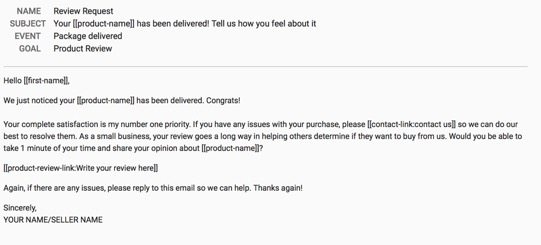Merchants on the Amazon marketplace realize the importance of product and seller reviews. Products with more reviews and better ratings appear higher in Amazon’s search results. Buyers also tend to trust products that have reviews of at least 3.5 stars.
However, getting positive reviews is not easy. Sellers sometimes use dubious tactics to obtain them. Many sellers use incentives to generate a higher volume of reviews. Others opt to post fake reviews. Buyers can often spot fake reviews, and Amazon adopted more stringent procedures to combat this practice. Getting caught will not only damage your reputation but could also get you thrown off the marketplace.
Thus the key is to get legitimate reviews from actual buyers.
Having a healthy mix of reviews — good and bad — increases your authenticity as a seller. Don’t be afraid of bad reviews. Respond to them because your response shows the potential buyers how you handle customer service issues. Buyers are suspect of a product that has all positive reviews.
In this post, I’ll address four ways of getting legitimate reviews on Amazon.
Buying experience
A buyer’s experience is the foundation for getting positive reviews. You cannot expect five stars for a mediocre product or bad service. The buying experience begins with your product pages and how you communicate with the potential buyer.
Always use a friendly and positive tone when describing your product. Focus on its solutions. Buyers never purchase features. They purchase benefits. They care only about how your product solves their problem.
Provide helpful photos of your product that clearly shows what the buyer can expect to receive. There is no reason for getting a “not as described” review. Receive enough of these and Amazon will delist your product. Attempting to embellish a product to get sales will be reflected in the reviews. Be confident and honest in describing your product.
Compelling inserts
Providing a personal touch to an ecommerce sales process can be difficult. However, it is essential to try to connect with the customer. One way to do this by putting printed inserts in the package.
An insert should reinforce your brand message and commitment to a positive customer experience. An instruction manual (where appropriate) and an explanation of the return process should also be provided. And don’t be shy about using inserts to asks for reviews.
Sellers who use creative inserts with their packages tend to receive positive reviews.
Post-purchase communication
Amazon does not share buyers’ email addresses with marketplace sellers. However, there are platforms, such as Feedback Genius, that connect to your seller account to send auto-responder emails to every buyer.
These emails can be highly effective. You can provide a direct link to the purchased product on Amazon to make it easy for the buyer to leave a review. The key is to make sure to first focus on the buyer’s satisfaction before asking for a review.
The screenshot below is an example of one of many templates available in Feedback Genius. The message reads:
Hello [first-name],
We just noticed your [product name] has been delivered. Congrats!
Your complete satisfaction is my number one priority. If you have any issues with your purchase, please [contact-link:contact us] so we can do our best to resolve them. As a small business, your review goes a long way in helping others determine if they want to buy from us. Would you be able to take 1 minute of your time and share your opinion about [product name]?
[product-review-link:Write your review here.]
Again, if there are any issues, please reply to this email so we can help. Thanks again!
Sincerely,
[Your name and seller name]

An example of a review template in Feedback Genius.
It typically takes more than one email to get a review. Sending three or four at different intervals is a good strategy. Once the buyer leaves feedback, send a thank you email, as well.
The process of using customer satisfaction emails for product reviews typically compels buyers to feel good about the product they just purchased. And asking for their feedback can get them engaged.
If a customer has had a bad experience, this follow-up communication can often remedy the problem. And once the issue is resolved, you can ask that customer for a review.
Amazon Vine and early reviewer program
Amazon’s Vine program can help sellers get reviews from certified Amazon reviewers.
To become a member of this program, your business should be part of the Vendor Express or Vendor Central service. The cost is $2,500 per ASIN (Amazon Standard Identification Number). The advantage of signing up is that you’ll likely increase the frequency and quality of reviews for your business.
For sellers on Amazon’s Brand Registry with Seller Central Accounts, Amazon has created the Early Reviewer program. The cost for this program is $60 per SKU, which will get you five product reviews. Other requirements are as follows.
- For an SKU-product to be eligible for the early reviewer program, it must have fewer than five reviews.
- The SKUs must be parent level or standalone. Variations are not allowed. Child SKUs are automatically enrolled with the parent.
- The offer price of each product must be greater than $15.
To be sure, the quality and value of a product are the primary elements in generating positive reviews. However, even the best products cannot on their own garner positive reviews, in my experience. It take good products, good customer service, and good post-purchase communication.
